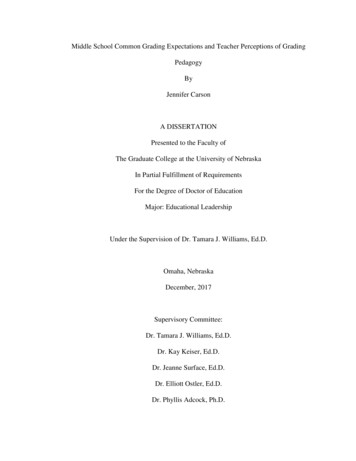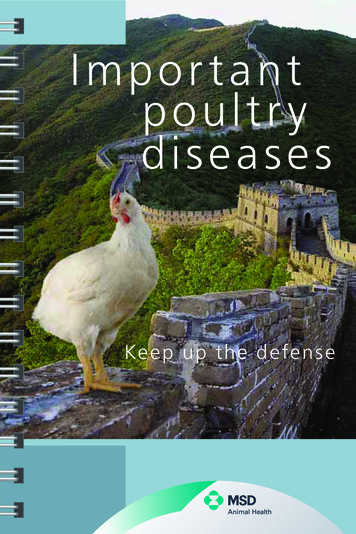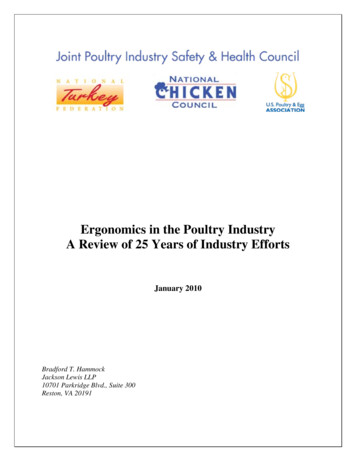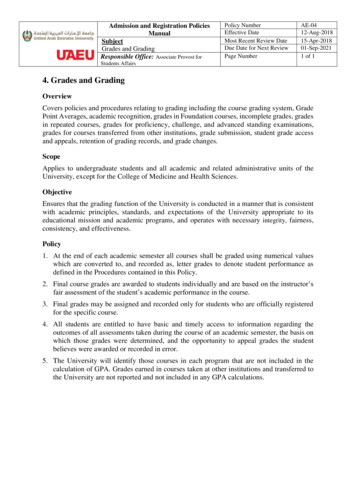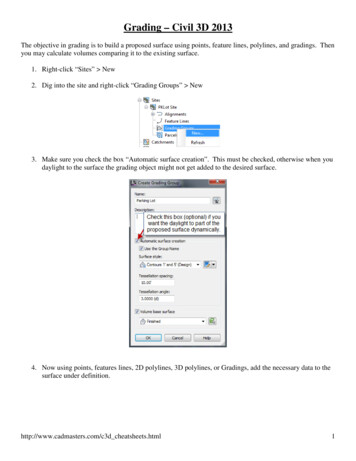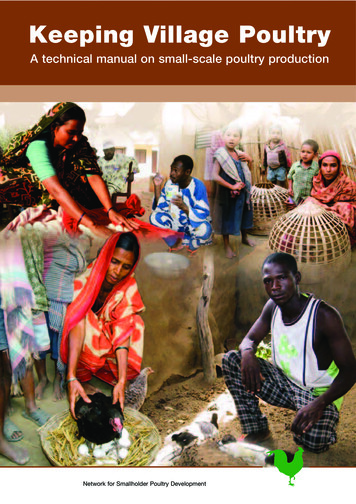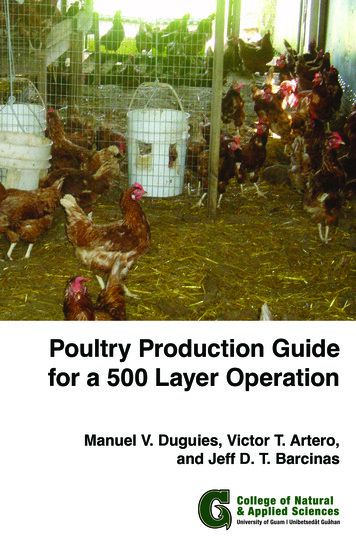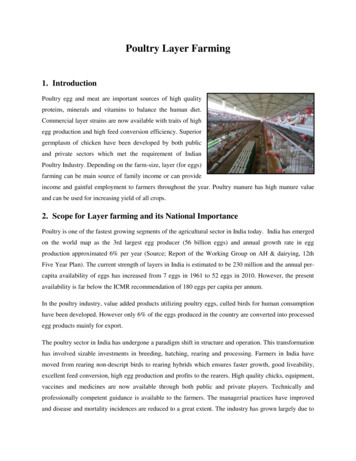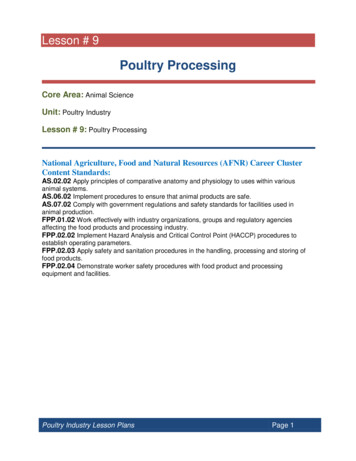
Transcription
United StatesDepartment radingManualAgricultureHandbookNumber 31PREPARED FROMPOULTRYDDDDDDDDDDDDDDDDDDThis symbol of assurance guaranteesthe product has been graded by the U.S.Department of Agriculture according tothe official US quality standardsDDDDDD
Contents . . . . . . . . . . . . . . . . . . . . . . . . . . . . . . . . . . PageI.Introduction. . . . . . . . . . . . . . . . . . . . . . . . . . . . . . . 2II.Poultry Grading and Certification Services. . . . . . . . 2A. Poultry Programs . . . . . . . . . . . . . . . . . . . . . . . . 2B. Poultry Eligible for Grading and Certification . . . . 3C. Official Identification Marks . . . . . . . . . . . . . . . . . 4III.Grading According to Quality Standardsand Grades. . . . . . . . . . . . . . . . . . . . . . . . . . . . . . . 6A. Uses of Standards and Grades. . . . . . . . . . . . . . 7B. Examining Carcasses and PartsTo Determine Quality . . . . . . . . . . . . . . . . . . . . . 7C. Quality Factors for Carcasses and Parts . . . . . . . 8D. Cutting Poultry Parts. . . . . . . . . . . . . . . . . . . . . . 9IV.U.S. Classes, Standards, and Grades for Poultry . . 16A. Classes of Ready-to-Cook Poultry . . . . . . . . . . 16B. Standards for Quality of Ready-to-CookIndividual Carcasses and Parts. . . . . . . . . . . . . 17C. Standards for Quality of Specified PoultryFood Products . . . . . . . . . . . . . . . . . . . . . . . . . 23D. Grades for Ready-to-Cook Poultry andSpecified Poultry Food Products . . . . . . . . . . . . 24V.Certification to Specific Purchase Requirements . . 30VI.Resource Materials Available . . . . . . . . . . . . . . . . 31Material in this manual is not copyrighted and may bereproduced with or without credit.Revised April 1998The U.S. Department of Agriculture (USDA) prohibits discrimination in all its programs and activities on the basis of race, color,national origin, gender, religion, age, disability, political beliefs,sexual orientation, and marital or family status. (Not all prohibitedbases apply to all programs.) Persons with disabilities who requirealternative means for communication of program information(Braille, large print, audiotape, etc.) should contact USDA’s TARGET Center at 202-720-2600 (voice and TDD).To file a complaint of discrimination, write USDA, Director, Office ofCivil Rights, Room 326-W, Whitten Building, 14th andIndependence Avenue, SW, Washington, DC 20250-9410 or call(202) 720-5964 (voice or TDD). USDA is an equal opportunityprovider and employer.1
I. IntroductionII. Poultry Grading and Certification ServicesThis manual is a guide to the uniform application of theU.S. Department of Agriculture (USDA) classes, standards,and grades for poultry, and to USDA’s voluntary poultrygrading and certification services. It can also serve as thecourse outline for a poultry grading school.Grading is classifying and sorting poultry according to various groups of conditions and quality characteristics.Ready-to-cook poultry carcasses and parts, and certainpoultry products, may be graded for quality according toofficial standards and grades.It is designed primarily to aid poultry graders. However, itshould also prove useful to those teaching poultry marketing, to quality control personnel in the poultry industry, andto volume food purchasers.Certification is verifying that ready-to-cook poultry carcasses, parts, and products meet the specific requirementsof a volume food buyer’s purchase contract or specification.Certificates or other documents issued may include certification for product condition and temperature, official verification of net weight, and grade yield.These services aid in the nationwide marketing of poultryand poultry products. They change from time to time as thetypes of products available change. Today, most chickensand turkeys reach the market in value-added forms, suchas cut-up parts, boneless and/or skinless cuts, and furtherprocessed products, including ready-to-cook and precooked entrees. This array of poultry and poultry productscan be found year-round in the fresh and frozen meat sections of the grocery store.The development of grade standards and the identificationand certification of class, quality, quantity, and condition ofagricultural products is authorized by the AgriculturalMarketing Act of 1946 (AMA). Regulations to implementthe AMA were developed in cooperation with State agriculture officials, producers, processors, and consumers.The use of grading and certification services is voluntary;the services are offered on a fee-for-service basis. Thosewho apply for service must also provide the space, equipment, lighting, or other facilities that are needed by thegrader or are required by the regulations. In addition, whengrading is performed in a plant, the plant and its facilitiesmust be approved by USDA.A. Poultry ProgramsVoluntary poultry grading and certification services are performed by the Poultry Programs of USDA’s AgriculturalMarketing Service (AMS). The Programs’ national officeoversees regional and State offices that supervise gradersstationed across the country.Resident grading is usually performed by a graderassigned to a specific processing plant on a full-time orpart-time basis. If multiple graders are assigned to a plant,one of them will be designated as the grader-in-charge.Most plants process large volumes of poultry. Since eachcarcass or part must be individually graded, plant employees authorized by the resident grader assist in the gradingprocess. These authorized graders examine and grade thepoultry according to the official quality standards. The resi-2
dent grader performs final checkgrading and certificationthrough a representative sampling plan.inspection service and are accepted are known as “officialestablishments.”Resident grading costs include an amount equal to thesalary of the resident grader, plus a charge based on thevolume of product handled in the plant to cover supervisoryand administrative costs. The cost per pound of poultry forthis service is generally little more than that incurred byplants employing their own graders and quality control personnel.Under the Poultry Products Inspection Act of 1957, USDAprovides mandatory Federal inspection of poultry and poultry products shipped in interstate or foreign commerce. TheWholesome Poultry Products Act of 1968 strengthened thatlaw and opened the way for vastly improved State poultryinspection systems. All poultry slaughtered for human fooddestined for sale in commerce must be processed, handled, packaged, and labeled in accordance with the Actand its regulations. Mandatory Federal inspection service,except for overtime and holiday work, is paid for by theGovernment.Most grading services provided to resident plants are alsoavailable on a temporary plant basis; that is, on an asneeded basis. Temporary plant fees are based on the timeneeded to perform the work. Temporary plants must meetall of the minimum facility, operating, and sanitary requirements specified in the regulations for resident service.Fee grading is performed when an applicant requestsgrading of a particular lot of poultry, often for verification ofnet weight, condition, or compliance with other contractrequirements. Requests for this type of service are usuallymade on an irregular basis and the charges are based onthe time needed to perform the work. Most fee gradingwork is done at locations other than processing plants,such as distribution facilities or destination points.Cooperative agreements between USDA and variousState agencies set forth procedures for the collection anddisbursement of fees.Under a State Trust Fund agreement, arrangements for service are between the State and individual firms, with theconcurrence of USDA. Fees are collected by the State.USDA is reimbursed by the State for Federal supervision ofthe program.Under a Federal Trust Fund agreement, applications forservice are between USDA and the individual firms. Feesare collected by USDA and the State is paid by USDA forthe costs it incurs performing grading work and supervision.B. Poultry Eligible for Grading and CertificationThe kinds of poultry eligible for grading and certificationinclude, but are not limited to, chickens, turkeys, ducks,geese, pigeons, and guineas. The form may be as aready-to-cook carcass or part or as a further processedproduct.States with inspection systems equal to the Federal program conduct inspection in plants shipping only within thatState. In States without such programs, intrastate plantsare also under Federal inspection.Voluntary inspection service for squab and game birds isprovided under authority of the AMA and the cost is paid bythe applicant.Administration of both mandatory and voluntary Federalinspection is the responsibility of USDA’s Food Safety andInspection Service (FSIS).After poultry has passed inspection and is ready to begraded or certified, the grader must be sure that it is still ina wholesome condition. Ready-to-cook poultry that is offcondition (slimy or slippery condition of the skin, putrid orsour odor) is ineligible for grading. In addition, ready-tocook poultry showing other non-acceptable conditions cannot be graded. If the grading is done at the processingplant, the poultry must be sent back for reworking. If thegrading is performed elsewhere, the number of carcassesor parts found with these conditions would be recorded,and the lot would be ineligible for grading. These conditions include excessive protruding feathers, bruises requiring trimming, lungs incompletely removed, parts of the trachea present, or extraneous material of any type inside oroutside of the carcass (i.e., fecal material, blood, grease,gall stains, dirt, metal, wood).All poultry that is graded or certified must first be inspected.Inspection refers to the wholesomeness of poultry and itsfitness for food. It is not concerned with quality or grade.The inspection mark means that the poultry has passedexamination by a qualified USDA veterinarian or inspectorduring slaughter and/or processing. All slaughter plants aresupervised by a USDA veterinarian. Plants which apply for3
C. Official Identification MarksLabels bearing the inspection mark are the responsibility ofFSIS. Questions regarding the accuracy and use of anylabel bearing the official grademark are handled throughFSIS. All labels bearing official grade identification are alsoreviewed by AMS to determine accuracy and for finalapproval.The inspection mark (fig. 1) is required on consumerpackages and shipping containers of poultry inspectedunder the Poultry Products Inspection Act.Marks on Consumer PackagesThe grademark must either be printed with light-coloredletters on a dark field (fig. 2a) or dark-colored letters on alight field (fig. 2b).As an alternative, the grademark may have three contrasting colored bands (fig. 3) provided the colors, from top tobottom, are blue, white, and red. Other color combinationsmay be used with AMS approval.The prepared from logo (fig. 4), in conjunction with theofficial grademark, may be used for raw, cooked, or furtherprocessed products which have no established grade standards. Such items include cooked, barbecued, color marinated chicken; batter/breaded poultry; and smoked products. These products are graded for all quality standardsprior to further processing that alters the grade factors.Marks on Shipping ContainersThis grademark (fig. 5) is used on containers to designatea consumer grade. The date the product was graded mayor may not be used in conjunction with the grademarkwhen applied by stamping. Preprinted grademarks do notrequire a date.The sample graded stamp (fig. 6) is used when grade certification is made in conjunction with other factors, such ascondition, test weighing, and temperature certification. Thisstamp may only be used when a certificate is actuallyissued and shall show the certificate number in the stamp.The contract compliance stamp (fig. 7) is used whenidentifying product that has been produced according toapproved specifications and is not to be applied until product is determined to be in compliance with all contractrequirements. The stamp must include the number of thecertificate issued for each shipment of complying product.The provisional stamp (fig. 8) is used on poultry gradedfor military contracts for troop issue and/or resale when purchased under military “orders for subsistence.” It is also tobe used on Veterans Administration products when purchased on Defense Personnel Support Center purchasecontracts. The certificate number is in this stamp. It is to4be applied at the time the product is determined to be incompliance with all contract requirements.The lot stamp (fig. 9) may be used to identify product thathas been graded according to special purchase requirements, such as product for commodity purchase programsplaced in a freezer until sufficient quantities accumulate forsubsequent sale and delivery. It may also be used to identify further-processed items produced according toapproved specifications. The consecutive day of the yearwhen the product was graded is in this stamp.The officially certified mark (fig. 10) is used on poultrysampled for temperature, condition, weight, or other certifications where the grade is not referenced on the certificateor when product is not identified with an official grade. Thisstamp may be used only when a certificate is actuallyissued and shall show the certificate number in the stamp.
Official Identification MarksFigure 1Figure 2aFigure 2bFigure 3Figure 4DDD D DDDDDDDDDDDDDDDDFigure 5Figure 6Figure 7DDDDDDFigure 8DDDFigure 9DDDDDDFigure 105
III. Grading According to Quality Standards andGradesQuality refers to the inherent properties of a product thatdetermine its relative degree of excellence or value.Experience and research have identified certain propertiesin poultry that are desired by producers, processors, andconsumers. Some of these properties are a good proportion of meat to bone, adequate skin covering, absence offeathers, and freedom from discolorations.Standards of quality enumerate the factors that affectthese properties and apply to individual ready-to-cook poultry carcasses, parts, and products. There are no gradestandards for giblets, detached necks and tails, wing tips,and skin.For carcasses and parts, the factors include conformation,fleshing, fat covering, defeathering, exposed flesh, discolorations, disjointed or broken bones, missing parts fromwhole carcasses, and freezing defects, if applicable. Forpoultry products, such as boneless-skinless breasts, factorsinclude presence of bones, tendons, cartilage, discolorations, and blood clots, as well as other product-specificfactors.Figure 11. Ready-to-cook young chicken. (Photo No. 96-CS-1482)Grades apply to lots of poultry of the same kind and class,each of which conforms to the requirements for the gradestandard. The U.S. consumer grades for poultry are U.S.Grades A, B, and C.Grading involves evaluating poultry in terms of the standards to determine the grade. Figures 11-14 show an Aquality young chicken, turkey, duck, and goose. A given lotof poultry may contain a small percentage of a quality lowerthan the grade specified because some defects are permitted. This is an unavoidable necessity due to today’s production-type processing methods.Poultry grade standards have changed over the years toreflect developments in poultry production, processing, andmarketing. Standards for ready-to-cook poultry were addedto the regulations in 1950. Roasts were added in 1965.Parts and boneless breasts and thighs were added in 1969.All provisions for grading live and dressed poultry wereeliminated in 1976. Large poultry parts, skinless carcassesand parts, and tenderloins were added in 1995. As theneed arises and meaningful quality factors are establishedfor other products, additional grade standards will bedeveloped.6Figure 12. Ready-to-cook young turkey. (Photo No. 96-CS-1483)Regulations provide penalties for the misuse of grading,such as the false representation that poultry has been officially graded. Products labeled with the terms “Prime,”“Choice,” and “Select,” which indicate superior or top quality,must be equivalent to U.S. Grade A. The letters “U.S.” or“USDA” may only be used with a poultry grademark if thepoultry has been graded by an authorized grader and subsequently checkgraded by a USDA grader. The lettergrades A, B, or C may only be used without the grademarkif the product has been graded by a USDA grader andmeets the requirements of the appropriate letter grade.The words “Prepared From,” or other similar wording, mayonly be used with the U.S. grademark if the product wasproduced from graded poultry.
Anyone with a financial interest in a lot of processedpoultry may apply to USDA to have an official grade designation placed on the lot or may use the grades as thebasis for negotiating loans, settling disputes involvingquality, or paying damage claims.B. Examining Carcasses and Parts To DetermineQualityIn today’s high-volume processing operations, poultry is initially graded by plant employees specifically authorized byUSDA to perform this work. Subsequently, the product ischeckgraded by a USDA grader to determine compliancewith applicable grade standards.Figure 13. Ready-to-cook young duck. (Photo No. 96-CS-1484)Figure 14. Ready-to-cook young goose. (Photo No. 96-CS-1485)A. Uses of Standards and GradesStandards and grades are used extensively throughout themarketing system. Grade standards furnish an acceptable common language that buyers and sellers use in trading and thatmarket news reporters use when communicating aboutmarket prices and supplies. Poultry firms that base the price paid to the grower ongrade yields will grade the product to USDA standards. Processors request grading service to enhance their ownquality assurance programs and so they may use the official grademark on each bird or package. The Department of Defense, airlines, grocery stores,fast-food restaurants, hospitals, schools, and other largescale food buyers specify USDA-graded poultry productsin their purchasing contracts. Commercial firms use the standards and grades as abasis for their own product specifications, for advertising,and for establishing brand names. Firms participating in the Department’s ExportEnhancement Program must use USDA’s grading services.Each carcass or part, including those used in preparing apoultry food product bearing the grademark, must be graded and identified in an unfrozen state on an individualbasis. The class must also be determined since the qualityfactors of fat, fleshing, and conformation vary with the ageand sex of the bird.Most carcasses and parts are graded on the production lineor out of the cooler. Poultry being graded should beapproximately reading distance from the grader’s eye.Whole carcasses can be examined by grasping the hocksof the bird in one hand with the breast up. In this position,the grader can easily observe the breast, wings, and legs,and by a mere twist of the wrist, the back of the bird can beturned into position to be observed. When parts are graded, the side nearest the grader should be examined first,then the part turned around so the opposite side can beexamined.The usual procedure is to decide on the conformation,fleshing and fat covering factors first. This makes it easierto decide on the other factors. The intensity, aggregatearea, location, and number of defects must also be evaluated. In each quality level there are maximum defects permitted, some varying with the weight of the ready-to-cookcarcass.The final quality rating is based on the factor with the lowest rating. Thus, if the requirements for A quality are met inall factors except one, and this factor is B quality, the finalgrade designation would be “B.” The carcass or part is thenplaced in the proper grade location by the grader or by anelectronically controlled computer system.When the resident grader checkgrades the product, theacceptable quality level (AQL) procedures used are basedon the percent of defective undergrade birds or parts present. If the AQL results show that there are excessiveundergrades, product is withheld until the undergrades areremoved. When excessive defects are encountered, thegraders work with plant management to help identify andcorrect the problem.7
C. Quality Factors for Carcasses and PartsThe following factors must be considered when determiningthe quality of an individual ready-to-cook carcass or part.ConformationThe structure or shape of the bird may affect the distribution and amount of meat, while certain defects detract fromits appearance. Some of the defects that should be notedare breasts that are dented, crooked, knobby, or V-shaped;backs that are crooked or hunched; legs and wings that aredeformed; and bodies that are definitely wedge-shaped.FleshingThe drumsticks, thighs, and breast carry the bulk of themeat. There is, however, a definite correlation between thecovering of the flesh over the back and the amount of fleshon the rest of the carcass. Females almost invariably carrymore flesh over the back and will generally have a morerounded appearance to the breast, thighs, and legs.The common defects in fleshing are breasts that are Vshaped or concave, rather than full and rounded; breaststhat are full near the wishbone, but taper sharply to therear; legs and drumsticks that are thin; and backs that haveinsufficient flesh to cover the vertebrae and hip bones.Fat CoveringFat in poultry is judged entirely by accumulation under theskin. This is true even for chicken parts. Accumulationsoccur first around the feather follicles in the heavy feathertracts. Poorly fattened birds may have some accumulationof fat in the skin along the heavy feather tracts on thebreast. Then, accumulations will be noted at the juncture ofthe wishbone and keel and where the thigh skin joins thebreast skin. At the same time, accumulations will be notedaround the feather follicles between the heavy feather tractsand over the back and hips. Well-finished older birds willhave sufficient fat in these areas and over the drumsticksand thighs so that the flesh is difficult to see. Fowl whichhave stopped laying have a tendency to take on excessivefat in the abdominal area. Younger birds will generally haveless fat under the skin between the heavy feather tracts onthe breast and over the drumsticks and thighs than maturebirds.FeathersProcessors try to eliminate the problem of feathers by moving poultry to slaughter after feathering cycles are over.There is, for instance, a very short period within which theslaughtering of ducklings must be done. With other classes, the period is longer and attention is given primarily tonoting if the bulk of the pins have sufficient brush on themto facilitate picking.Protruding feathers have broken through the skin and mayor may not have formed a brush. Nonprotruding feathers8are evident but have not pushed through the outer layer ofskin.Before a quality designation can be assigned, ready-tocook poultry must be free of protruding feathers that arevisible to a grader during examination of the carcass at normal operating speeds. However, a carcass may be considered as being free from protruding feathers if it has a generally clean appearance (especially on the breast and legs)and if not more than an occasional protruding feather is inevidence during a more careful examination of the carcass.Hair on chickens, turkeys, guineas, and pigeons; and downon ducks and geese must also be considered.Exposed Flesh, Cuts, Tears, and Broken BonesExposed flesh can result from cuts, tears, missing skin, orbroken or disjointed bones. It detracts from the appearanceof the carcasses and parts and permits the flesh to dry outduring cooking, thus lowering the eating quality. The number and extent of such defects permitted depend on theirlocation—whether on the breast, legs, or elsewhere.Skin Discolorations, Flesh Blemishes, and BruisesMost poultry is packaged in material that reduces exposureto air. However, in time the skin will still dry out andbecome discolored. If drying has occurred, the size of theareas is taken into consideration as a discoloration.Discolorations are categorized as slight, lightly shaded, ormoderate. Slight discolorations are generally pinkish incolor and usually do not detract from the appearance of theproduct. Lightly shaded discolorations are generally reddish in color and usually confined to areas of the skin orthe surface of the flesh. Moderately shaded discolorationsare areas that are generally dark red or bluish, or are areasof flesh bruising.Bruises in the flesh are permitted only to the extent thatthere is no coagulation or clotting of blood cells. Smallclots in the skin or on the surface of the flesh may be cut toallow them to leach out in the chilling process. Such cutswould be taken into consideration in determining the quality. Dark blue or green bruises must be removed beforegrading. Excessive grade loss because of bruises shouldbe called to the attention of management.The intensity of the yellow finish on chicken is not a qualityfactor. The presence of yellow skin occurs genetically whena caratenoid pigment is deposited in the epidermal layer ofskin. The yellow skin color is commonly intensified byincorporating pigments known as xanthophylls into thebird’s diet. If poultry firms scald poultry at lower temperatures (124 to 126 F), the epidermal layer of skin (cuticle)remains on the chicken and its yellow appearance isenhanced. For the fast-food market wanting batter/breaded
fried products or for customers preferring a lighter appearance on poultry, firms will scald poultry at higher temperatures (132 to 136 F) to remove the cuticle. This enhancesthe bonding of the batter/breading to the chicken skin, butextra precautions must be taken to reduce the exposure ofthe product to air.Freezing DefectsDiscoloration and dehydration of poultry skin or the surfaceof skinless products during storage is commonly called“freezer burn.” This defect detracts from the appearance ofthe product and, in the case of either moderate or severefreezer burn, lowers the quality of the poultry.Slow freezing promotes ice formation on the outside of themeat tissue cells, drawing water out of the cells, possiblypreventing the tissue from ever freezing, and causing thetissue to dehydrate and shrink. Also, larger ice crystals areformed that may rupture the cells causing the release of thecell contents, increasing drip loss, and resulting in a lessjuicy and softer textured product as the muscle structurebreaks down. This can adversely affect the shelf life of theproduct.D. Cutting Poultry PartsThe USDA standards of quality apply to poultry parts cut inthe manner described below and illustrated in figures 1529. While most descriptions were developed when partswere cut from a carcass by hand, most processors todaydisjoint whole carcasses by machine. Machine-cut partsmay be graded provided they are not misshapen and havenearly the same appearance as they had prior to cuttingfrom the carcass. Under certain conditions, parts cut inother ways may also be officially identified when properlylabeled. Only skin or fat normally associated with a partmay be included unless stated on the label.The illustration of the skeleton of a chicken (fig. 30) showsthe points where the parts are cut and gives the names ofthe skeletal parts.Slow freezing also affects product color. It causes bonedarkening as bone marrow material is released into thebone structure and adjacent meat. It causes dark carcasses as the transparency of the skin increases, thus allowingthe dark color of the meat to show through the skin.Poultry quality and stability are adversely affected at temperatures above 10 F. Poultry products begin to thaw fromthe outside in once the product temperature reaches a temperature above 10 F, at which time seepage of moisturefrom the defrosting product results in clear, pinkish, or reddish colored layers of ice. Poultry located in the center of atightly stacked pallet may not freeze if cold air is preventedfrom circulating between and around the individual cases.9
Poultry halves (fig. 15) are prepared by making a fulllength back and breast split of the carcass to produceapproximately equal right and left sides. Portions of thebackbone must remain on both halves. The cut may be nomore than one-fourth inch from the outer edge of the sternum (breastbone).Rear poultry halves include both legs and adjoining portion of the back.Quarters consist of the entire eviscerated poultry carcasswhich has been cut into four equal parts, excluding theneck.Breast quarters (fig. 17) consist of half a breast with thewing and a portion of the back attached.Figure 15. Poultry halves. (Photo No. 96-CS-1486)Figure 17. Breast quarters. (Photo No. 96-CS-1488)Front poultry halves (fig. 16) include the full breast withcorresponding back portion, and may or may not includewings, wing meat, or portions of wing.Breast quarters without wing consist of a breast quarterof a poultry carcass from which the wing has beenremoved.Leg quarters (fig. 18) consist of a thigh and drumstick, witha portion of the back attached. It may also includeattached abdominal fat and a maximum of two ribs. A legwith a complete or entire rear back portion attached mayalso be grade identified if certain criteria are met.Figure 16. Front poultry half. (Photo No. 96-CS-1487)10Figure 18. Leg quarters. (Photo No. 96-CS-1489)
Breasts are separated from the back at the shoulder jointand by a cut running backward and downward from thatpoint along the junction of the vertebral and sternal ribs.The ribs may be removed from the breasts, and the breastsmay be cut along the breastbone to make two approximately equal halves; or the wishbone portion may be removedbefore cutting the remainder along the breastbone
This manual is a guide to the uniform application of the U.S.Department of Agriculture (USDA) classes, standards, and grades for poultry, and to USDA's voluntary poultry grading and certification services. It can also serve as the course outline for a poultry grading school. It is designed primarily to aid poultry graders. However, it
